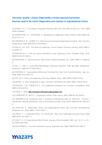Organizational culture has a fundamental influence on the functioning of organizations of various kinds. According to Michael Armstrong and Tino Stephens [2] it creates a sense of identity and unity of purpose, a sense of existence for members of the organization, helps create commitment, and helps shape behavior because it provides a guide for what is expected of employees in the organization.
"However, the term organizational culture is not only used to denote a positive organizational culture that contributes to the successful functioning of the organization. Organizations can also have a poor organizational culture that is not in their favor in achieving their long-term visions. Such an organizational culture can lead to unproductive behavior, i.e. it will work against the organization and its goals. If such a phenomenon appears in the organization, it is necessary to start working on change." [5]
In this blog, we focus on the real need of leaders to know the current and desirable state of their organizational culture.
What is organizational culture? What is hidden under this term?
Organizational culture is a phenomenon that began to appear in practice in the 1970s. The cause of this interest in organizational culture was the "Japanese economic miracle", which managers and organizational theorists perceived as a huge challenge.
Another reason, according to I. Nový and R. Lukášová [13], was the search for a path to perfection and efficiency in company management. However, the specific definition of this term still remains very diverse. The most representative authors from this field agree that organizational culture can be understood as a set of basic assumptions, values, attitudes and norms of behavior that are shared within the organization and are manifested in the thinking, feelings and behavior of the members of the organization, as well as in material and non-material artefacts.
We, as consultants and experts who are dedicated to diagnosing and creating a desirable organizational culture in the long term, identify with the objectivist understanding of organizational culture. We understand organizational culture as an objective entity, as a certain aspect or subsystem of the organization, as one of the organizational variables that, along with other variables (structure, systems, etc.), affects the functioning and performance of the organization. We are of the opinion that it can be purposefully shaped and changed.
Based on the study of professional literature in the field of management, organizational ethics, organizational theory and organizational leadership and the search for an intersection between these subject areas, we can conclude that congruent behavior (formally declared behavior is in agreement with real behavior) has a fundamental influence on the real form of organizational culture. Or otherwise, the opposite results can be caused by non-congruent behavior and actions (formally declared behavior is not consistent with real behavior) of top representatives of organizations, i.e. leaders.
The relationship of morally congruent actions and behaviour of leaders as an important part of organizational culture and leadership can be represented as a chain of individual links in the following way (see figure below).
Leadership Long-term success
↓ ↗
Organizational culture → Trust
Graphic representation of the relationship of ethics as part of organizational culture and people management (source: W. D. Hitt)
At the beginning of this chain there is leadership, which is represented by the leader. Leaders have many options to influence the entire process of shaping organizational culture. They can act congruently with the formally declared organizational philosophy and values, so that the consequence is gaining the natural respect and authority of the moral leader, or they can influence the formation or deforming the organizational culture by its incongruent actions, as a result of which the organization supports destructive practices that lead to inefficient achievement of organizational goals.
In this blog, we want to drive your attention to the recording of our past webinar focused on "Diagnosis and creation of organizational culture", where we explained the need to know the real state of organizational culture.
More info & webinar recording
In our work, we emphasize the importance and great added value of moral leadership for creating an ethical organizational culture. As we can see from the mentioned chain, it is the leaders who have a direct influence on the creation and formation or deformation of the ethical organizational culture. Assuming that the leader influences the creation of an ethical organizational culture, which in turn supports ethical behavior, building trust is a natural response.
We could call trust the miraculous element of this chain that unites and cements the entire organization. Without this important link, the organization would be just a group of different individuals, in which everyone goes his own way and promotes only his own interests. "Trust is that wonderful thing that can do great wonders in an organization." [9].
All this leads to the last link in the chain, which is long-term success. The long-term success of organizations of various kinds can be defined as effectively meeting the needs of all interest groups of these organizations.









